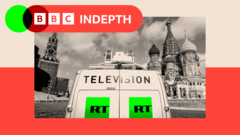In an increasingly complex global landscape, Russian state-backed media outlets like RT (Russia Today) and Sputnik are strategically expanding their influence beyond Western borders, aiming to tap into markets where anti-Western sentiments run high. Following severe restrictions imposed by the US, UK, Canada, and the EU after Russia's invasion of Ukraine, these media platforms have sought new audiences in regions like Africa, Latin America, and the Middle East.
In a recent incident in Chile, television viewer Javier Gallardo found himself bewildered when his local cable channel, Telecanal, suddenly broadcast news from RT—a transitional move likely intended to increase RT's footprint in Latin America without prior notice to audiences. The channel faced impending sanctions from local regulators for this unannounced shift, which reflects broader trends in how RT is capitalizing on reduced competition from Western media outlets that have faced budget cuts and have downsized operations.
Simultaneously, RT has initiated new projects, such as launching a bureau in Algeria and providing training for journalists across various regions, further signifying its long-term strategy of embedding itself into diverse media landscapes domestically disrupted by significant shifts in funding and resources.
Experts suggest that Russian media serves a dual purpose: countering Western narratives while bolstering local disinterest. In many regions, RT is viewed not merely as a propaganda tool but as a credible source of information. Researchers who analyzed RT's coverage found indications that the channel’s adaptation to local contexts enhances its reception, particularly among audiences feeling marginalized by dominant Western media narratives.
In Africa, the media's growth coincides with a historical legacy of Soviet support for liberation movements, fostering a perception of Russia as a partner rather than an adversary. This newfound focus is an opportunity for Russia to build alliances, undermine Western influence, and promote its geopolitical agenda. The establishment of the new Sputnik bureau in Ethiopia exemplifies this strategy, reflecting a broader aim to consolidate support and counter narratives unfavorable to Russian interests.
Additionally, RT's competitive edge lies in its ability to cater content to specific regions. In the Middle East, it targets pro-Palestinian sentiments during the Israel-Gaza conflict, while in Latin America, it broadcasts content in Spanish to reach large populations that might otherwise overlook its narratives.
Despite challenges such as being banned on platforms like YouTube, RT finds alternative routes to maintain visibility—suggesting an adaptable strategy that leverages local media practices. Furthermore, recent studies indicate that an earnest effort is underway to present Russia as a defender of the Global South and as a victim of Western aggression.
As Russia navigates these tumultuous waters, the danger lies in the potential to normalize its actions globally while presenting itself in a more benign light. Observers warn that the expansion of state-backed media like RT represents not just an effort to increase viewership, but a bid to reshape the global information landscape amid an evolving world order.
The responses from RT to accusations regarding their narratives remain limited, only confirming their expansionary strategy. Analysts urge vigilance against the ramifications of this media surge, which may signify Russia's increasing presence on the world stage, with potential repercussions for the future of democratic discourse and the information ecosystem.
















